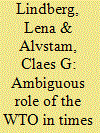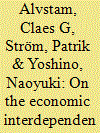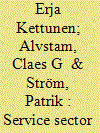|
|
|
Sort Order |
|
|
|
Items / Page
|
|
|
|
|
|
|
| Srl | Item |
| 1 |
ID:
113961


|
|
|
|
|
| Publication |
2012.
|
| Summary/Abstract |
The world trading system is characterized by a growing number of free trade agreements (FTAs). Limited progress in the negotiations at the multilateral level within the WTO has contributed to this development, inducing countries to seek faster, alternative ways to speed up liberalization, which make it possible to take advantage of preferential treatment with key trading partners. This article discusses what role the WTO should take with regard to FTAs in times of stalled multilateral negotiations and proliferating FTAs, and how FTAs can contribute to the multilateralization of regionalism. When results at the multilateral level are scarce, there may be a shift towards other alternatives in which the WTO is left out. This may force the WTO to function reactively, simply facing facts as an organization, rather than proactively, where it may play some role in shaping the FTA development. FTAs are not an entirely separate phenomenon from the WTO, since countries that negotiate FTAs play two roles. They are members of the WTO and as such are part of the work and negotiations of the organization. They are also part of trade arrangements that are limited to a smaller number of countries, and hence can negotiate against the interest of the entire multilateral organization. This article explores how these agreements can facilitate the work and negotiations of the WTO to regionalize bilateralism and multilateralize regionalism, here named the "sticky rice" approach. Various East Asian trade arrangements are used as empirical examples.
|
|
|
|
|
|
|
|
|
|
|
|
|
|
|
|
| 2 |
ID:
090019


|
|
|
|
|
| Publication |
2009.
|
| Summary/Abstract |
The paper presents an analysis of the economic relationship between the two most important economies in Asia. Over the last decades, the Chinese and Japanese economies have become more economically interdependent, a development which will, in the long run, impact the countries' political relationship. The paper seeks to answer the question: How can China and Japan gain from the current economic situation, further enhance their relationship and increase their synergies for regional economic development? Data on trade and Foreign Direct Investment are used in combination with primary data from interviews with Japanese and Chinese companies on how they perceive the current business situation and future potential. The result of the data analysis shows that the countries have much to gain from their economic interdependence. The firms see great potential in their respective markets but are concerned about political turbulence. Three possible scenarios for the future economic relationship are presented, including fierce competition on all markets and a leveraging of resources for mutual development between Chinese and Japanese companies.
|
|
|
|
|
|
|
|
|
|
|
|
|
|
|
|
| 3 |
ID:
152938


|
|
|
|
|
| Summary/Abstract |
The aim of this paper is to investigate how new rules and practices in multilateral, regional and bilateral trade negotiations related to the services industries can be adopted and implemented at the business level, using the recently concluded free-trade agreement (FTA) negotiations between the EU and Singapore as an illustrative case. The purpose is to put the services sector into the larger framework of business service interaction between the EU and the outside world by identifying crucial sub-sectors within the services industries and their relations to physical, ‘visible’ production and trade. Furthermore, to assess the prospects of ‘multilateralising’ regional trade agreements within the service sector, through the ambitions by both parties to make bilateral and interregional FTAs and EPAs more compatible and mutually comparable with the multilateral GATS’ rules. The EU-Singapore FTA is an agreement that became a ‘second-best’ solution of the stalled interregional EU-ASEAN negotiation, taking place 2006–2009. It can nevertheless be seen as a ‘WTO-plus’ endeavour, since it aims at reaching beyond what is under negotiation in the likewise stalled Doha Development Agenda within the WTO framework, particularly in the fields of business services, public procurement, intellectual property rights, trade-related investment measures, and, generally, competition rules. Since both parties already apply low or zero tariffs in most sectors of manufacturing, the main issues in the negotiations were related to services in general and knowledge-intensive business services in particular, with an emphasis on technical barriers to trade.
|
|
|
|
|
|
|
|
|
|
|
|
|
|
|
|
|
|
|
|
|